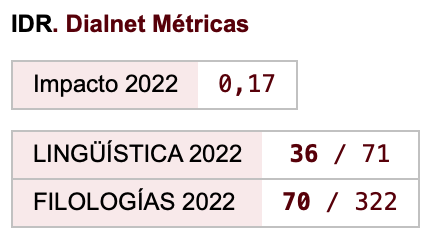Evidence of audience in MS Hunter 93, a medical text
Keywords:
audience, medical text, context of situation, recipes, evidentialityAbstract
The aim of this paper is to explore the concept and evidence of audience in the text of MS Hunter 93 (T.4.10), a remedy book written in the second half of the 16th century (c.a. 1565). This manual is presented by its author as a book addressed to anyone who “has not a physician at hand”, so it is presumably intended to a general audience. Several studies about the classification of medical texts have taken into account the audience as a criterion for taxonomy (academic or non-academic). My intention is to show how audience is codified in language by means of strategies such as specific use of vocabulary and the authorities quoted in the running text. My ultimate goal is to see whether the author has really written his text for a general audience, as he affirms in the prologue, or whether he has failed to do so and so we should not take his initial statement at face value.
Downloads
References
Alonso-Almeida, F. (1998-1999). ‘Gyf hyr this medycyn’: Analysing the Middle English medical recipe discourse. Revista de Lenguas para Fines Específicos 5/6, 15-46.
Alonso-Almeida, F., & Carroll, R. (2004). A new proposal for the classification of Middle English medical texts. In A. Rodríguez-Álvarez & F. Alonso-Almeida (Eds.), Voices on the past. Studies in Old and Middle English language and literature (pp. 21-33). Netbiblo.
Alonso-Almeida, F. (2000). Edition and study of a Late Medieval English medical receptarium. G.U.L. MS Hunter 185 (T.8.17). Unpublished Doctoral Dissertation. University of Las Palmas de Gran Canaria. Spain.
Alonso-Almeida, F. (forthcoming). ‘Compiled rather for those which are to vse it, then for the learned’. The concept of audience in fifteenth and sixteenth century texts on medicine. Homenaje al Profesor Enrique Alcaraz.
Aikhenvald, A. Y. (2004). Evidentiality. Oxford: Oxford University Press. Barton, D. (1994). Literacy: An introduction to the ecology of written language. Oxford:
Blackwell.
Feckenham, John de (1921-1922). In The Dictionary of National Biography. Vol.
VI (Drant-Finan). Oxford: Oxford University Press
Feckenham, John de (2010). In Encyclopaedia Britannica. Retrieved April 10, 2010, form Encyclopaedia Britannica Online: http://search.eb.com/eb.article- 9033890.
Grossmann, F., & Wirth, F. (2007). Marking evidentiality in scientific papers: the case of expectation markers. In K. Flottum (Ed.), Language and discipline perspectives on academic discourse (pp. 202-218). Newcastle, UK: Cambridge scholars publishing.
Halliday, M. A. K., & Hasan, R. (1989). Language, context, and text: Aspects of language in a social-semiotic perspective. Oxford: Oxford University Press.
Henslow, G. (1925). Medical works of the fourteenth century together with a list of plants recorded in contemporary writing with the identifications. New York: Burt Franklin.
Malinowski, B. (1923). The problem of meaning in primitive languages, Supplement 1 in C. K. Odgen & I. A. Richards (Eds.), The meaning of meaning, international library of philosophy, psychology and scientific method. London: Kegan Paul.
McDowell, R. (1988, September/October). Poetry and audience. Poets and Writers Magazine 16(5), 19-27.
Ogden, M. S. (1988). ‘The Liber de Diversis Medicinis’ in the Thornton manuscript (MS Lincoln Cathedral A.5.2). London: Oxford University Press.
Overstreet, M. (2005). And stuff und so: Investigating pragmatic expressions in English and German. Journal of Pragmatics 37, 1845-1864.
Pahta, P. (2004). Code-switching in medieval medical writing. In I. Taavitsainen and P. Pahta (Eds). Medical and scientific writing in Late Medieval English (pp. 73- 99). Cambridge: Cambridge University Press.
Siraisi, M. (1990). Medieval and Early Renaissance Medicine. An introduction to knowledge and practice. Chicago and London: The University of Chicago Press.
Taavitsainen, I. (2001). Middle English recipes. Genre characteristics, text type features and underlying yraditions of writing. Journal of Historical Pragmatics 2(1), 85-113.
Taavitsainen, I. (2004). Scriptoral ‘House-Styles’ and discourse communities. In I. Taavitsainen and P. Pahta (Eds.). Medical and scientific writing in Late Medieval English (pp. 209-240). Cambridge: Cambridge University Press.
Voigts, L. E. (1982). Editing Middle English medical yexts: Needs and issues. In Trevor H. Levere (Ed.), Editing texts in the history of science and medicine (pp. 39-68). New York: Garland.
Willet, T. (1988). A cross-linguistic survey of grammaticalization of evidentiality. Studies in Language, 12, 51-97.
Downloads
Published
How to Cite
Issue
Section
License
Authors who publish with this journal agree to the following terms:
- Authors retain copyright and grant the journal right of first publication with the work simultaneously licensed under a Creative Commons Attribution License that allows others to share the work with an acknowledgement of the work's authorship and initial publication in this journal.
- Authors are able to enter into separate, additional contractual arrangements for the non-exclusive distribution of the journal's published version of the work (e.g., post it to an institutional repository or publish it in a book), with an acknowledgement of its initial publication in this journal.
- Authors are permitted and encouraged to post their work online (e.g., in institutional repositories or on their website) prior to and during the submission process, as it can lead to productive exchanges, as well as earlier and greater citation of published work (See The Effect of Open Access).

Revista de Lenguas para fines específicos is licensed under a Creative Commons Reconocimiento-NoComercial-SinObraDerivada 4.0 Internacional License.























